Evaluating Workplace Discrimination's Impact on Employee Performance
VerifiedAdded on 2023/01/06
|8
|1574
|28
Project
AI Summary
This research project investigates the impact of workplace discrimination on employee performance, focusing on a case study of Morrison, a UK supermarket chain. The project begins with an introduction outlining the aim, background, objectives, research questions, rationale, significance, and scope of the study. A comprehensive literature review examines the concept of workplace discrimination, factors contributing to it, and the challenges in implementing equality and diversity. The research employs a qualitative methodology, utilizing an inductive approach and interpretivism philosophy for in-depth analysis. Primary data collection involves questionnaires administered to managers, while secondary data includes journals, articles, and online sources. Thematic analysis is used for data analysis, with attention to reliability, validity, and ethical considerations, including informed consent and limitations. The project includes a timeline for completion and concludes with a list of cited references.
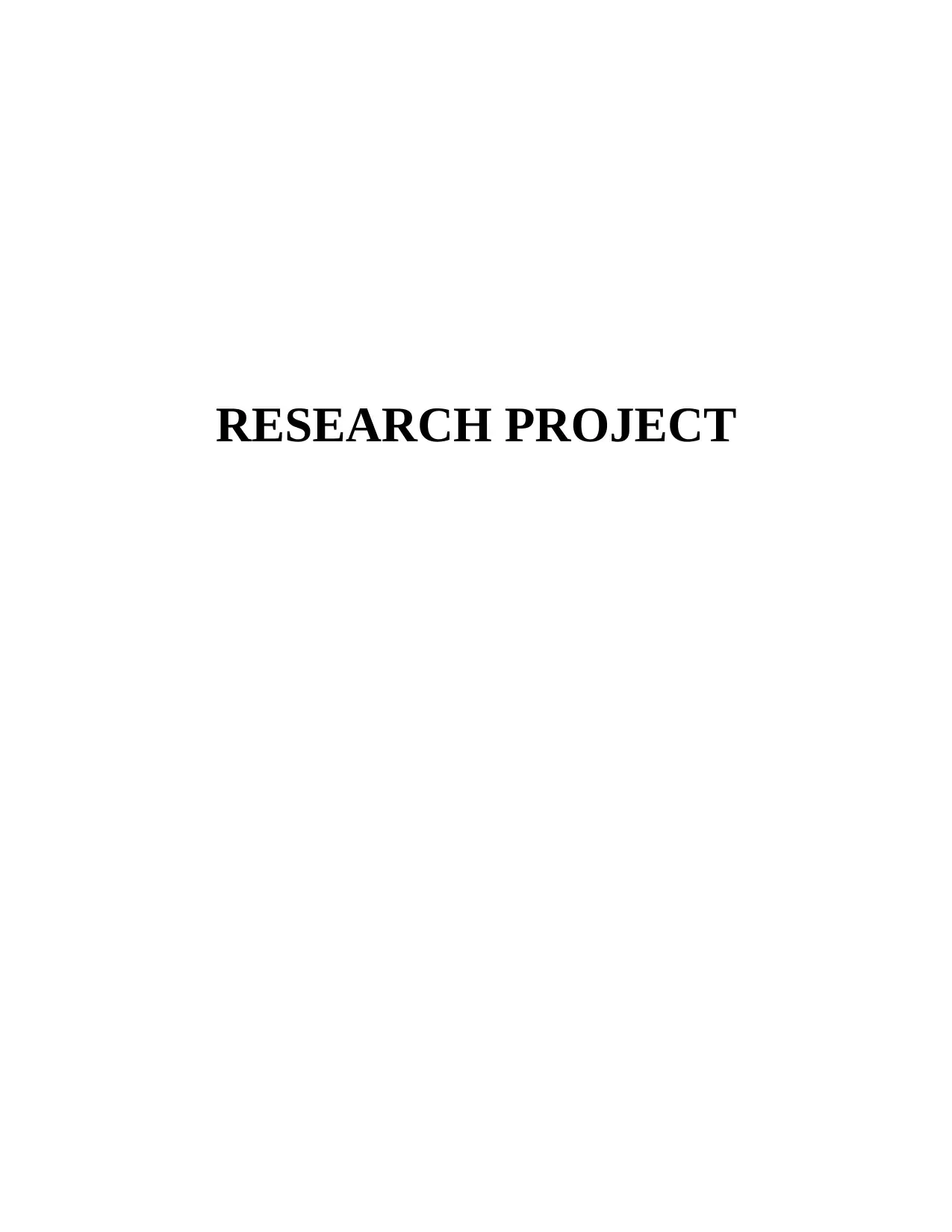
RESEARCH PROJECT
Paraphrase This Document
Need a fresh take? Get an instant paraphrase of this document with our AI Paraphraser
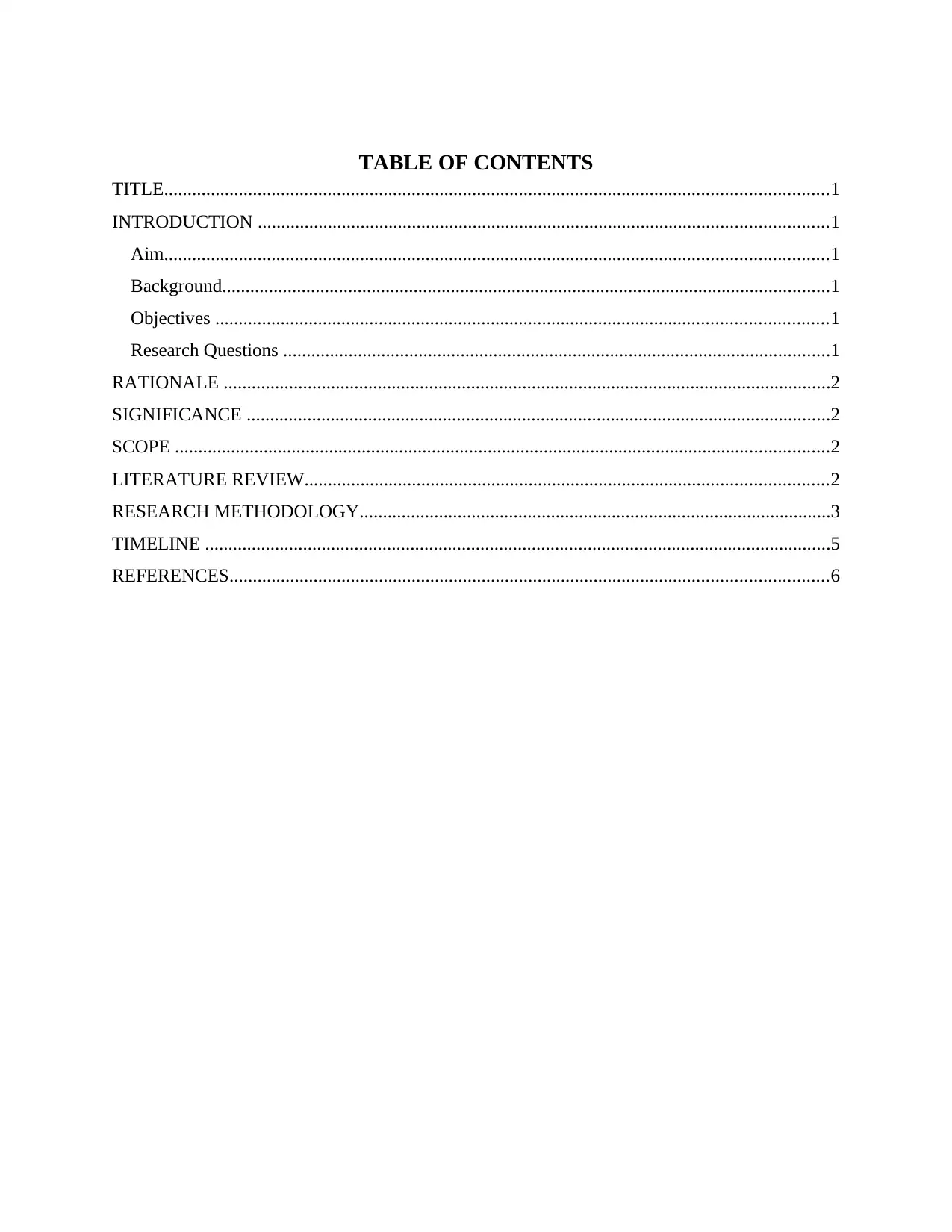
TABLE OF CONTENTS
TITLE..............................................................................................................................................1
INTRODUCTION ..........................................................................................................................1
Aim..............................................................................................................................................1
Background..................................................................................................................................1
Objectives ...................................................................................................................................1
Research Questions .....................................................................................................................1
RATIONALE ..................................................................................................................................2
SIGNIFICANCE .............................................................................................................................2
SCOPE ............................................................................................................................................2
LITERATURE REVIEW................................................................................................................2
RESEARCH METHODOLOGY.....................................................................................................3
TIMELINE ......................................................................................................................................5
REFERENCES................................................................................................................................6
TITLE..............................................................................................................................................1
INTRODUCTION ..........................................................................................................................1
Aim..............................................................................................................................................1
Background..................................................................................................................................1
Objectives ...................................................................................................................................1
Research Questions .....................................................................................................................1
RATIONALE ..................................................................................................................................2
SIGNIFICANCE .............................................................................................................................2
SCOPE ............................................................................................................................................2
LITERATURE REVIEW................................................................................................................2
RESEARCH METHODOLOGY.....................................................................................................3
TIMELINE ......................................................................................................................................5
REFERENCES................................................................................................................................6
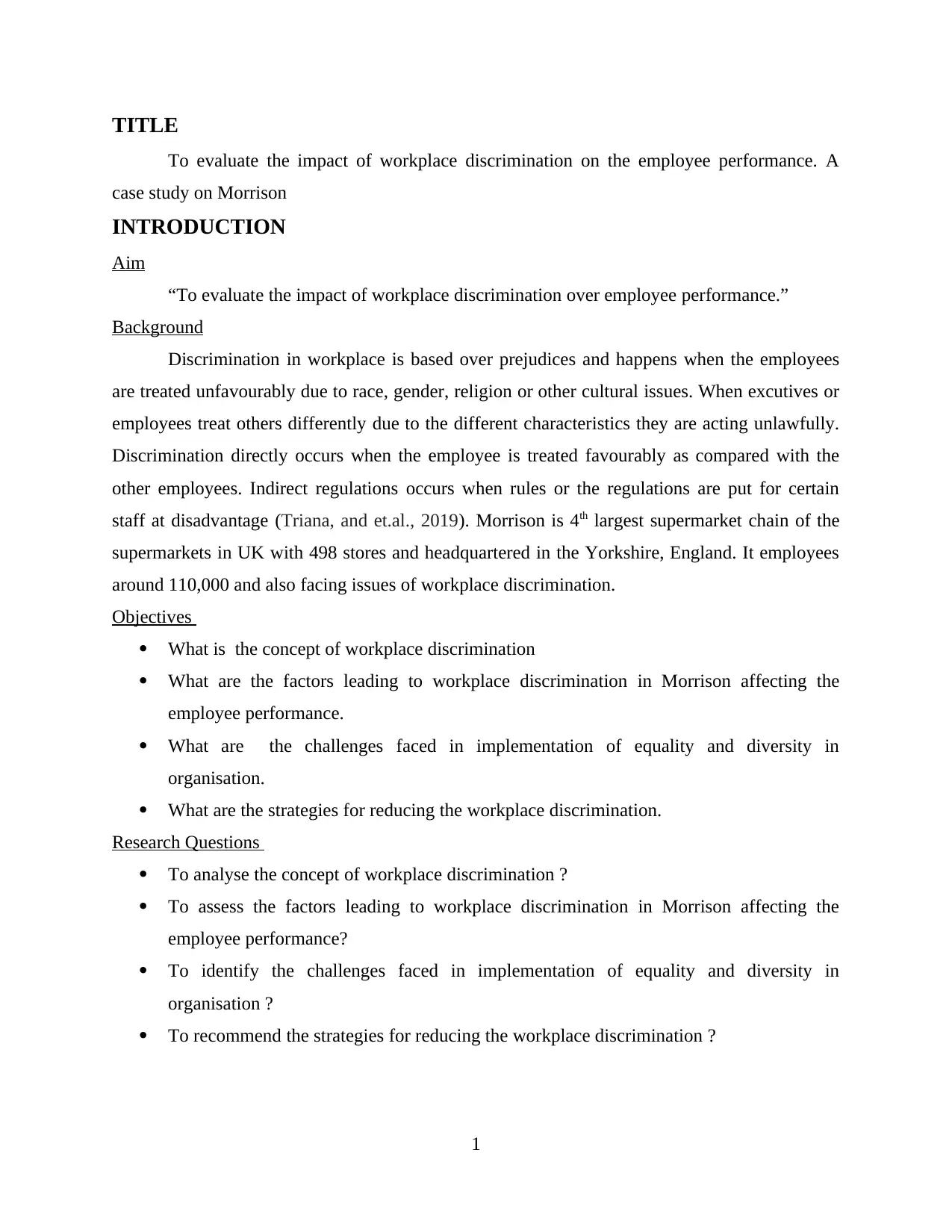
TITLE
To evaluate the impact of workplace discrimination on the employee performance. A
case study on Morrison
INTRODUCTION
Aim
“To evaluate the impact of workplace discrimination over employee performance.”
Background
Discrimination in workplace is based over prejudices and happens when the employees
are treated unfavourably due to race, gender, religion or other cultural issues. When excutives or
employees treat others differently due to the different characteristics they are acting unlawfully.
Discrimination directly occurs when the employee is treated favourably as compared with the
other employees. Indirect regulations occurs when rules or the regulations are put for certain
staff at disadvantage (Triana, and et.al., 2019). Morrison is 4th largest supermarket chain of the
supermarkets in UK with 498 stores and headquartered in the Yorkshire, England. It employees
around 110,000 and also facing issues of workplace discrimination.
Objectives
What is the concept of workplace discrimination
What are the factors leading to workplace discrimination in Morrison affecting the
employee performance.
What are the challenges faced in implementation of equality and diversity in
organisation.
What are the strategies for reducing the workplace discrimination.
Research Questions
To analyse the concept of workplace discrimination ?
To assess the factors leading to workplace discrimination in Morrison affecting the
employee performance?
To identify the challenges faced in implementation of equality and diversity in
organisation ?
To recommend the strategies for reducing the workplace discrimination ?
1
To evaluate the impact of workplace discrimination on the employee performance. A
case study on Morrison
INTRODUCTION
Aim
“To evaluate the impact of workplace discrimination over employee performance.”
Background
Discrimination in workplace is based over prejudices and happens when the employees
are treated unfavourably due to race, gender, religion or other cultural issues. When excutives or
employees treat others differently due to the different characteristics they are acting unlawfully.
Discrimination directly occurs when the employee is treated favourably as compared with the
other employees. Indirect regulations occurs when rules or the regulations are put for certain
staff at disadvantage (Triana, and et.al., 2019). Morrison is 4th largest supermarket chain of the
supermarkets in UK with 498 stores and headquartered in the Yorkshire, England. It employees
around 110,000 and also facing issues of workplace discrimination.
Objectives
What is the concept of workplace discrimination
What are the factors leading to workplace discrimination in Morrison affecting the
employee performance.
What are the challenges faced in implementation of equality and diversity in
organisation.
What are the strategies for reducing the workplace discrimination.
Research Questions
To analyse the concept of workplace discrimination ?
To assess the factors leading to workplace discrimination in Morrison affecting the
employee performance?
To identify the challenges faced in implementation of equality and diversity in
organisation ?
To recommend the strategies for reducing the workplace discrimination ?
1
⊘ This is a preview!⊘
Do you want full access?
Subscribe today to unlock all pages.

Trusted by 1+ million students worldwide
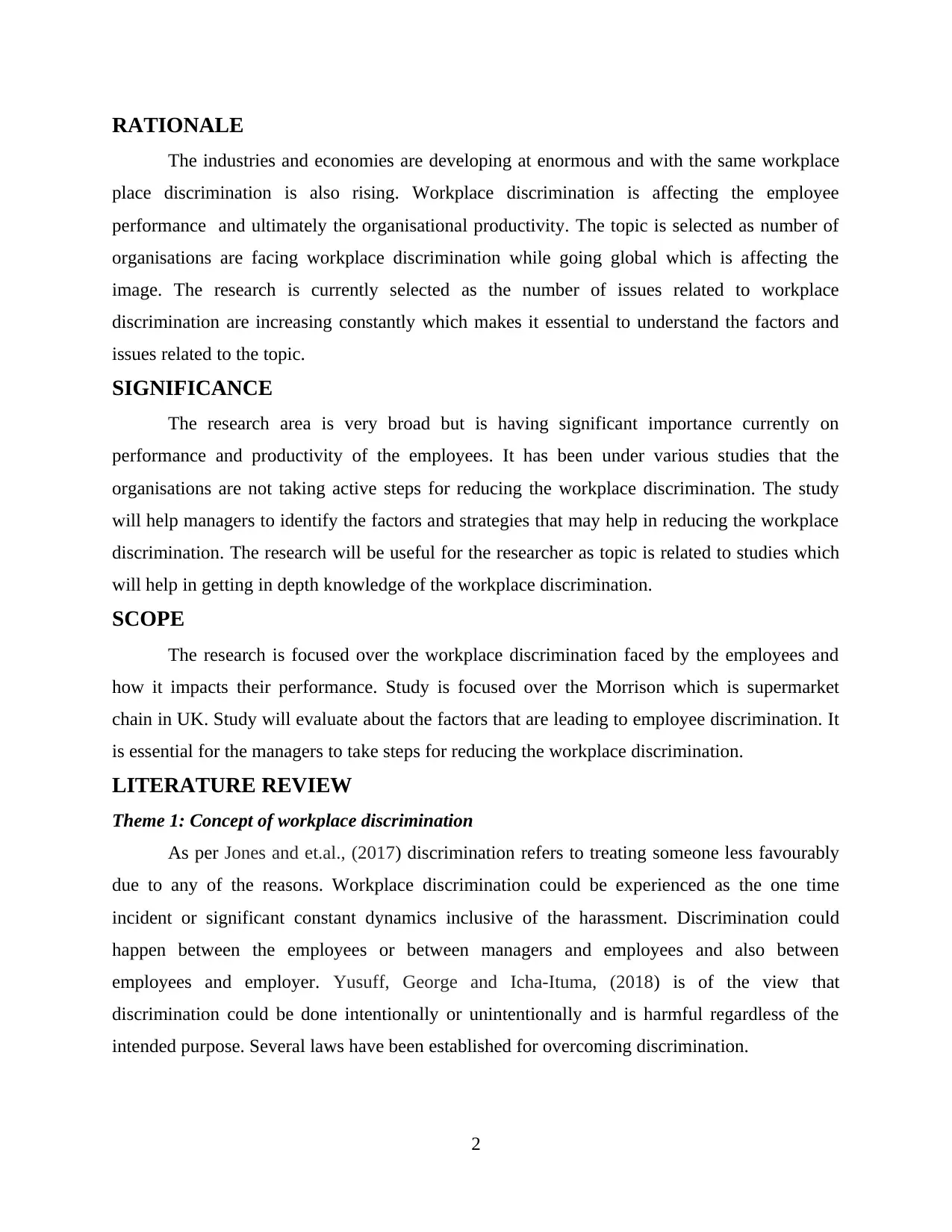
RATIONALE
The industries and economies are developing at enormous and with the same workplace
place discrimination is also rising. Workplace discrimination is affecting the employee
performance and ultimately the organisational productivity. The topic is selected as number of
organisations are facing workplace discrimination while going global which is affecting the
image. The research is currently selected as the number of issues related to workplace
discrimination are increasing constantly which makes it essential to understand the factors and
issues related to the topic.
SIGNIFICANCE
The research area is very broad but is having significant importance currently on
performance and productivity of the employees. It has been under various studies that the
organisations are not taking active steps for reducing the workplace discrimination. The study
will help managers to identify the factors and strategies that may help in reducing the workplace
discrimination. The research will be useful for the researcher as topic is related to studies which
will help in getting in depth knowledge of the workplace discrimination.
SCOPE
The research is focused over the workplace discrimination faced by the employees and
how it impacts their performance. Study is focused over the Morrison which is supermarket
chain in UK. Study will evaluate about the factors that are leading to employee discrimination. It
is essential for the managers to take steps for reducing the workplace discrimination.
LITERATURE REVIEW
Theme 1: Concept of workplace discrimination
As per Jones and et.al., (2017) discrimination refers to treating someone less favourably
due to any of the reasons. Workplace discrimination could be experienced as the one time
incident or significant constant dynamics inclusive of the harassment. Discrimination could
happen between the employees or between managers and employees and also between
employees and employer. Yusuff, George and Icha-Ituma, (2018) is of the view that
discrimination could be done intentionally or unintentionally and is harmful regardless of the
intended purpose. Several laws have been established for overcoming discrimination.
2
The industries and economies are developing at enormous and with the same workplace
place discrimination is also rising. Workplace discrimination is affecting the employee
performance and ultimately the organisational productivity. The topic is selected as number of
organisations are facing workplace discrimination while going global which is affecting the
image. The research is currently selected as the number of issues related to workplace
discrimination are increasing constantly which makes it essential to understand the factors and
issues related to the topic.
SIGNIFICANCE
The research area is very broad but is having significant importance currently on
performance and productivity of the employees. It has been under various studies that the
organisations are not taking active steps for reducing the workplace discrimination. The study
will help managers to identify the factors and strategies that may help in reducing the workplace
discrimination. The research will be useful for the researcher as topic is related to studies which
will help in getting in depth knowledge of the workplace discrimination.
SCOPE
The research is focused over the workplace discrimination faced by the employees and
how it impacts their performance. Study is focused over the Morrison which is supermarket
chain in UK. Study will evaluate about the factors that are leading to employee discrimination. It
is essential for the managers to take steps for reducing the workplace discrimination.
LITERATURE REVIEW
Theme 1: Concept of workplace discrimination
As per Jones and et.al., (2017) discrimination refers to treating someone less favourably
due to any of the reasons. Workplace discrimination could be experienced as the one time
incident or significant constant dynamics inclusive of the harassment. Discrimination could
happen between the employees or between managers and employees and also between
employees and employer. Yusuff, George and Icha-Ituma, (2018) is of the view that
discrimination could be done intentionally or unintentionally and is harmful regardless of the
intended purpose. Several laws have been established for overcoming discrimination.
2
Paraphrase This Document
Need a fresh take? Get an instant paraphrase of this document with our AI Paraphraser
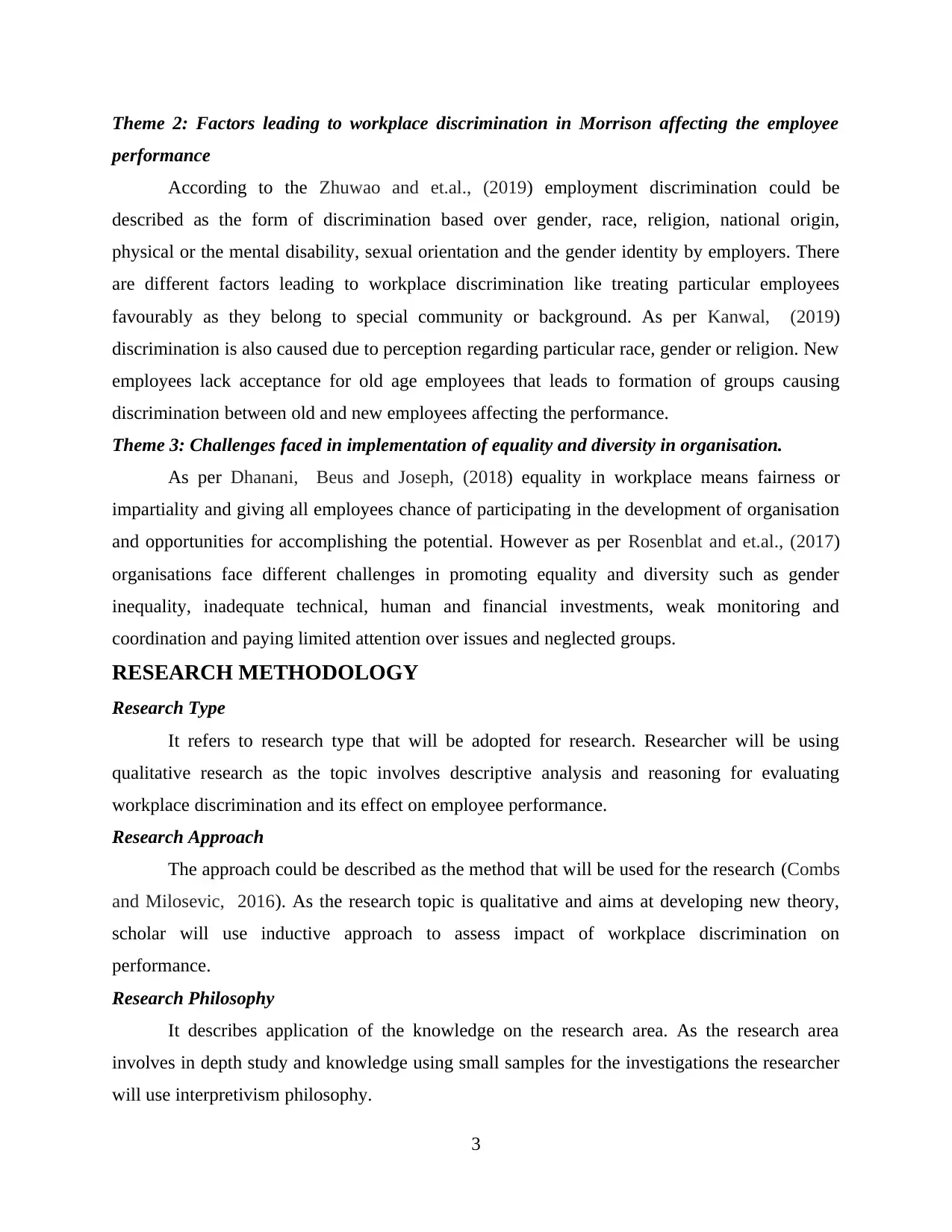
Theme 2: Factors leading to workplace discrimination in Morrison affecting the employee
performance
According to the Zhuwao and et.al., (2019) employment discrimination could be
described as the form of discrimination based over gender, race, religion, national origin,
physical or the mental disability, sexual orientation and the gender identity by employers. There
are different factors leading to workplace discrimination like treating particular employees
favourably as they belong to special community or background. As per Kanwal, (2019)
discrimination is also caused due to perception regarding particular race, gender or religion. New
employees lack acceptance for old age employees that leads to formation of groups causing
discrimination between old and new employees affecting the performance.
Theme 3: Challenges faced in implementation of equality and diversity in organisation.
As per Dhanani, Beus and Joseph, (2018) equality in workplace means fairness or
impartiality and giving all employees chance of participating in the development of organisation
and opportunities for accomplishing the potential. However as per Rosenblat and et.al., (2017)
organisations face different challenges in promoting equality and diversity such as gender
inequality, inadequate technical, human and financial investments, weak monitoring and
coordination and paying limited attention over issues and neglected groups.
RESEARCH METHODOLOGY
Research Type
It refers to research type that will be adopted for research. Researcher will be using
qualitative research as the topic involves descriptive analysis and reasoning for evaluating
workplace discrimination and its effect on employee performance.
Research Approach
The approach could be described as the method that will be used for the research (Combs
and Milosevic, 2016). As the research topic is qualitative and aims at developing new theory,
scholar will use inductive approach to assess impact of workplace discrimination on
performance.
Research Philosophy
It describes application of the knowledge on the research area. As the research area
involves in depth study and knowledge using small samples for the investigations the researcher
will use interpretivism philosophy.
3
performance
According to the Zhuwao and et.al., (2019) employment discrimination could be
described as the form of discrimination based over gender, race, religion, national origin,
physical or the mental disability, sexual orientation and the gender identity by employers. There
are different factors leading to workplace discrimination like treating particular employees
favourably as they belong to special community or background. As per Kanwal, (2019)
discrimination is also caused due to perception regarding particular race, gender or religion. New
employees lack acceptance for old age employees that leads to formation of groups causing
discrimination between old and new employees affecting the performance.
Theme 3: Challenges faced in implementation of equality and diversity in organisation.
As per Dhanani, Beus and Joseph, (2018) equality in workplace means fairness or
impartiality and giving all employees chance of participating in the development of organisation
and opportunities for accomplishing the potential. However as per Rosenblat and et.al., (2017)
organisations face different challenges in promoting equality and diversity such as gender
inequality, inadequate technical, human and financial investments, weak monitoring and
coordination and paying limited attention over issues and neglected groups.
RESEARCH METHODOLOGY
Research Type
It refers to research type that will be adopted for research. Researcher will be using
qualitative research as the topic involves descriptive analysis and reasoning for evaluating
workplace discrimination and its effect on employee performance.
Research Approach
The approach could be described as the method that will be used for the research (Combs
and Milosevic, 2016). As the research topic is qualitative and aims at developing new theory,
scholar will use inductive approach to assess impact of workplace discrimination on
performance.
Research Philosophy
It describes application of the knowledge on the research area. As the research area
involves in depth study and knowledge using small samples for the investigations the researcher
will use interpretivism philosophy.
3
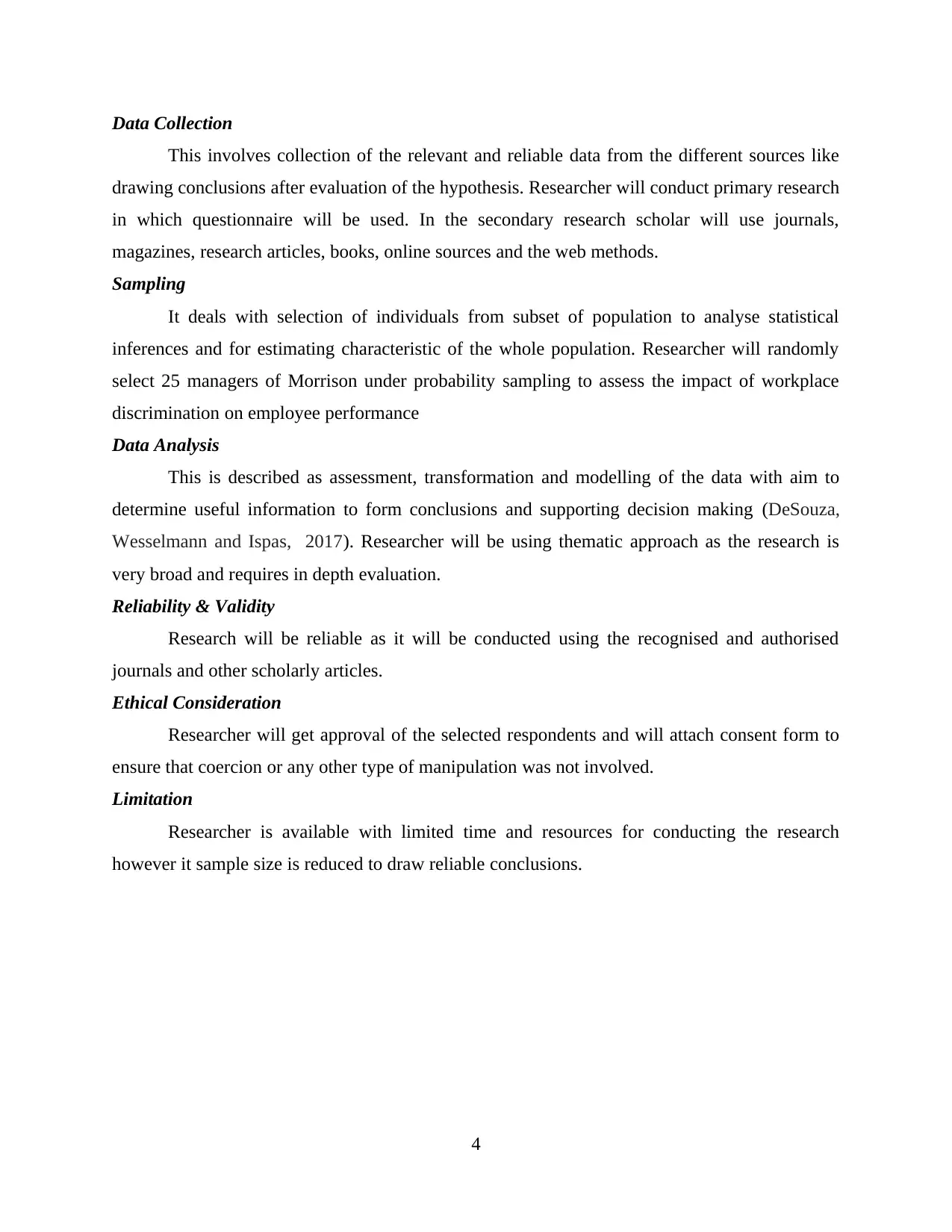
Data Collection
This involves collection of the relevant and reliable data from the different sources like
drawing conclusions after evaluation of the hypothesis. Researcher will conduct primary research
in which questionnaire will be used. In the secondary research scholar will use journals,
magazines, research articles, books, online sources and the web methods.
Sampling
It deals with selection of individuals from subset of population to analyse statistical
inferences and for estimating characteristic of the whole population. Researcher will randomly
select 25 managers of Morrison under probability sampling to assess the impact of workplace
discrimination on employee performance
Data Analysis
This is described as assessment, transformation and modelling of the data with aim to
determine useful information to form conclusions and supporting decision making (DeSouza,
Wesselmann and Ispas, 2017). Researcher will be using thematic approach as the research is
very broad and requires in depth evaluation.
Reliability & Validity
Research will be reliable as it will be conducted using the recognised and authorised
journals and other scholarly articles.
Ethical Consideration
Researcher will get approval of the selected respondents and will attach consent form to
ensure that coercion or any other type of manipulation was not involved.
Limitation
Researcher is available with limited time and resources for conducting the research
however it sample size is reduced to draw reliable conclusions.
4
This involves collection of the relevant and reliable data from the different sources like
drawing conclusions after evaluation of the hypothesis. Researcher will conduct primary research
in which questionnaire will be used. In the secondary research scholar will use journals,
magazines, research articles, books, online sources and the web methods.
Sampling
It deals with selection of individuals from subset of population to analyse statistical
inferences and for estimating characteristic of the whole population. Researcher will randomly
select 25 managers of Morrison under probability sampling to assess the impact of workplace
discrimination on employee performance
Data Analysis
This is described as assessment, transformation and modelling of the data with aim to
determine useful information to form conclusions and supporting decision making (DeSouza,
Wesselmann and Ispas, 2017). Researcher will be using thematic approach as the research is
very broad and requires in depth evaluation.
Reliability & Validity
Research will be reliable as it will be conducted using the recognised and authorised
journals and other scholarly articles.
Ethical Consideration
Researcher will get approval of the selected respondents and will attach consent form to
ensure that coercion or any other type of manipulation was not involved.
Limitation
Researcher is available with limited time and resources for conducting the research
however it sample size is reduced to draw reliable conclusions.
4
⊘ This is a preview!⊘
Do you want full access?
Subscribe today to unlock all pages.

Trusted by 1+ million students worldwide
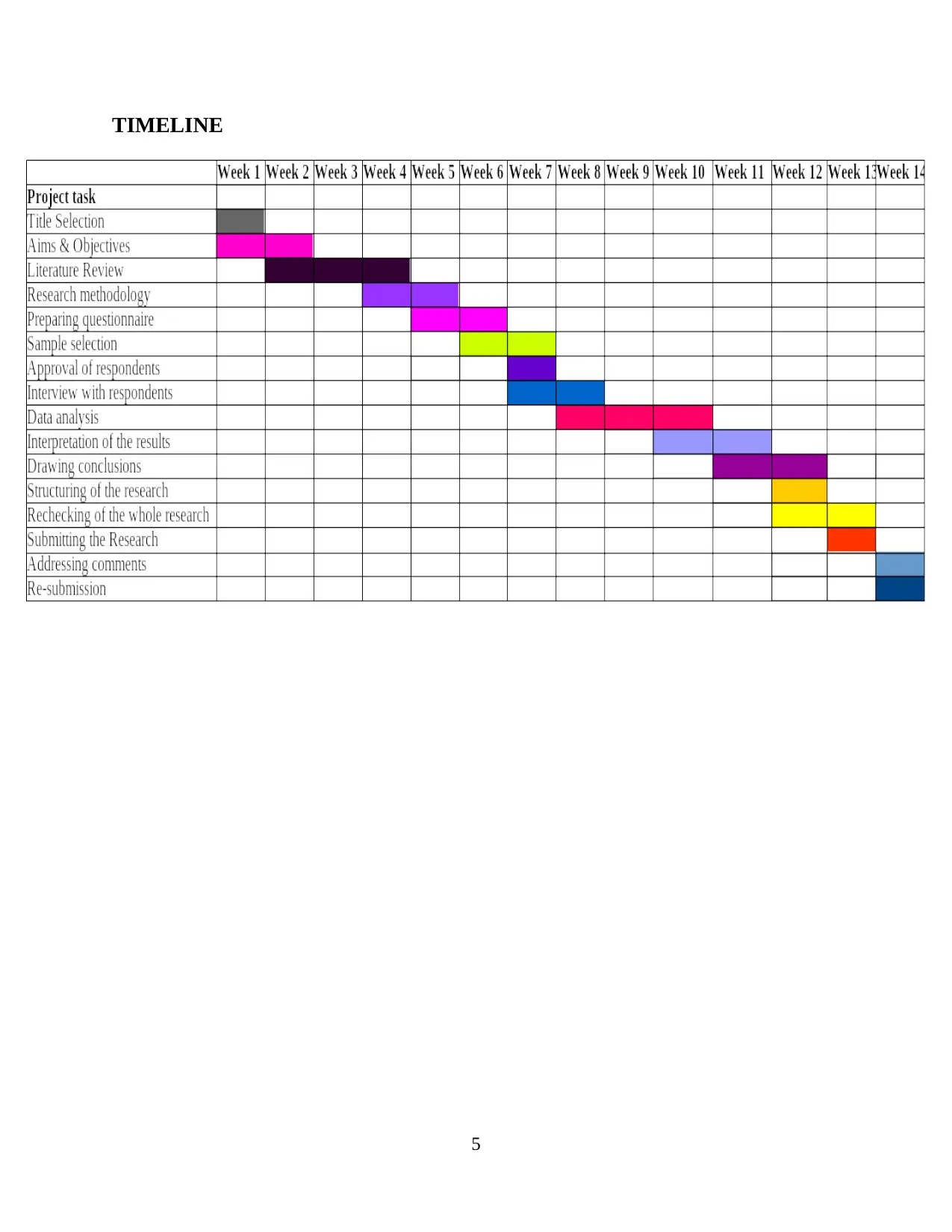
TIMELINE
5
5
Paraphrase This Document
Need a fresh take? Get an instant paraphrase of this document with our AI Paraphraser
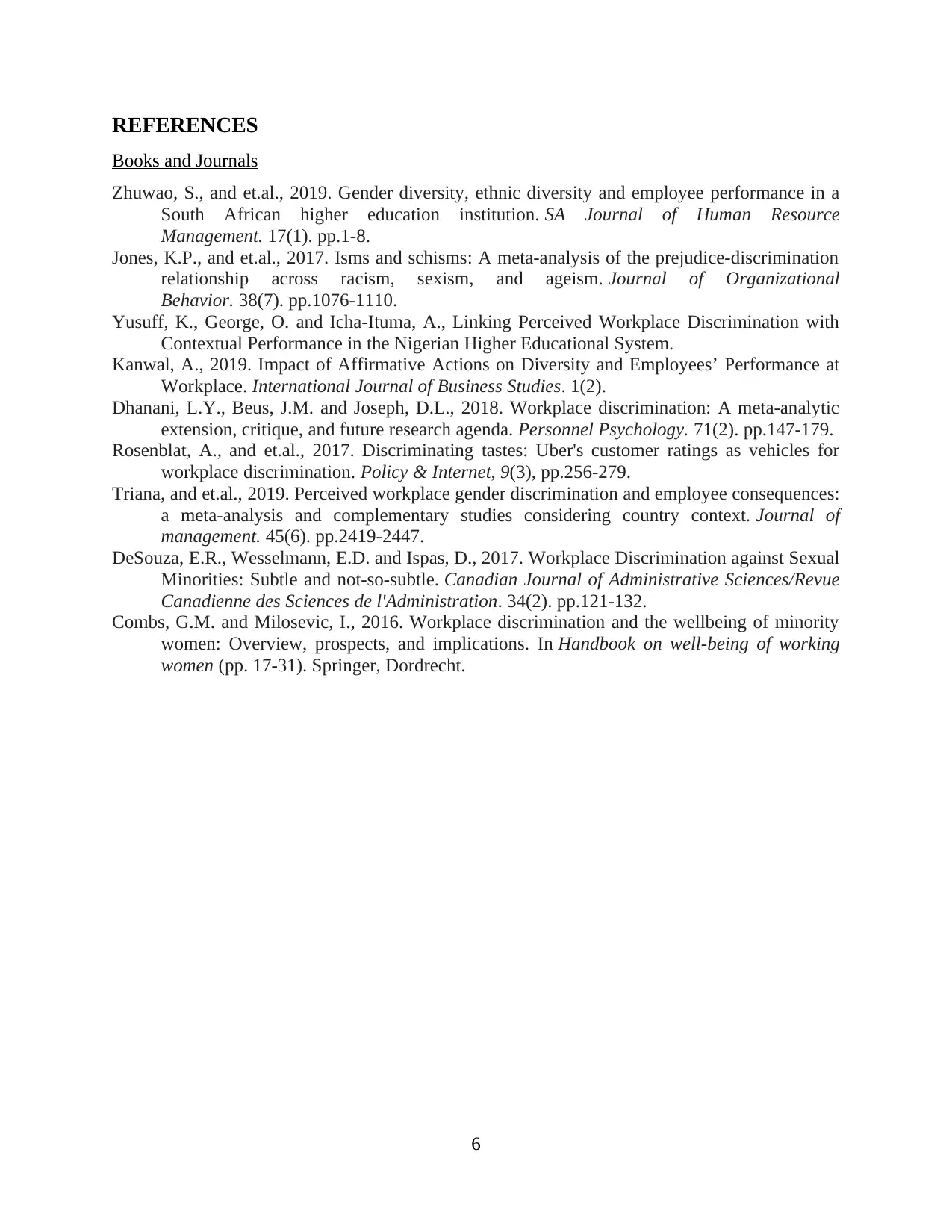
REFERENCES
Books and Journals
Zhuwao, S., and et.al., 2019. Gender diversity, ethnic diversity and employee performance in a
South African higher education institution. SA Journal of Human Resource
Management. 17(1). pp.1-8.
Jones, K.P., and et.al., 2017. Isms and schisms: A meta‐analysis of the prejudice‐discrimination
relationship across racism, sexism, and ageism. Journal of Organizational
Behavior. 38(7). pp.1076-1110.
Yusuff, K., George, O. and Icha-Ituma, A., Linking Perceived Workplace Discrimination with
Contextual Performance in the Nigerian Higher Educational System.
Kanwal, A., 2019. Impact of Affirmative Actions on Diversity and Employees’ Performance at
Workplace. International Journal of Business Studies. 1(2).
Dhanani, L.Y., Beus, J.M. and Joseph, D.L., 2018. Workplace discrimination: A meta‐analytic
extension, critique, and future research agenda. Personnel Psychology. 71(2). pp.147-179.
Rosenblat, A., and et.al., 2017. Discriminating tastes: Uber's customer ratings as vehicles for
workplace discrimination. Policy & Internet, 9(3), pp.256-279.
Triana, and et.al., 2019. Perceived workplace gender discrimination and employee consequences:
a meta-analysis and complementary studies considering country context. Journal of
management. 45(6). pp.2419-2447.
DeSouza, E.R., Wesselmann, E.D. and Ispas, D., 2017. Workplace Discrimination against Sexual
Minorities: Subtle and not‐so‐subtle. Canadian Journal of Administrative Sciences/Revue
Canadienne des Sciences de l'Administration. 34(2). pp.121-132.
Combs, G.M. and Milosevic, I., 2016. Workplace discrimination and the wellbeing of minority
women: Overview, prospects, and implications. In Handbook on well-being of working
women (pp. 17-31). Springer, Dordrecht.
6
Books and Journals
Zhuwao, S., and et.al., 2019. Gender diversity, ethnic diversity and employee performance in a
South African higher education institution. SA Journal of Human Resource
Management. 17(1). pp.1-8.
Jones, K.P., and et.al., 2017. Isms and schisms: A meta‐analysis of the prejudice‐discrimination
relationship across racism, sexism, and ageism. Journal of Organizational
Behavior. 38(7). pp.1076-1110.
Yusuff, K., George, O. and Icha-Ituma, A., Linking Perceived Workplace Discrimination with
Contextual Performance in the Nigerian Higher Educational System.
Kanwal, A., 2019. Impact of Affirmative Actions on Diversity and Employees’ Performance at
Workplace. International Journal of Business Studies. 1(2).
Dhanani, L.Y., Beus, J.M. and Joseph, D.L., 2018. Workplace discrimination: A meta‐analytic
extension, critique, and future research agenda. Personnel Psychology. 71(2). pp.147-179.
Rosenblat, A., and et.al., 2017. Discriminating tastes: Uber's customer ratings as vehicles for
workplace discrimination. Policy & Internet, 9(3), pp.256-279.
Triana, and et.al., 2019. Perceived workplace gender discrimination and employee consequences:
a meta-analysis and complementary studies considering country context. Journal of
management. 45(6). pp.2419-2447.
DeSouza, E.R., Wesselmann, E.D. and Ispas, D., 2017. Workplace Discrimination against Sexual
Minorities: Subtle and not‐so‐subtle. Canadian Journal of Administrative Sciences/Revue
Canadienne des Sciences de l'Administration. 34(2). pp.121-132.
Combs, G.M. and Milosevic, I., 2016. Workplace discrimination and the wellbeing of minority
women: Overview, prospects, and implications. In Handbook on well-being of working
women (pp. 17-31). Springer, Dordrecht.
6
1 out of 8
Related Documents
Your All-in-One AI-Powered Toolkit for Academic Success.
+13062052269
info@desklib.com
Available 24*7 on WhatsApp / Email
![[object Object]](/_next/static/media/star-bottom.7253800d.svg)
Unlock your academic potential
Copyright © 2020–2025 A2Z Services. All Rights Reserved. Developed and managed by ZUCOL.





